Analyzing Snapchat's Dynamic Strategy, Stakeholders, and Innovation
VerifiedAdded on 2023/06/07
|12
|2995
|401
Report
AI Summary
This report provides an analysis of Snapchat's stakeholders and strategic development. It identifies key stakeholders such as managers, owners, employees, customers, suppliers, society, creditors, government, and shareholders, detailing their roles and objectives. The analysis includes behavior assessments, motivations, and categorization of stakeholders into primary, secondary, excluded, and connected groups. The report also explores Snapchat's generic strategy programs, including cost leadership, focus, differentiation, and integrated cost leadership-differentiation strategies. Finally, it offers recommendations for each stakeholder group, emphasizing the importance of customer trust, employee engagement, supplier quality, and the effectiveness of a differentiation strategy for Snapchat's competitive advantage.
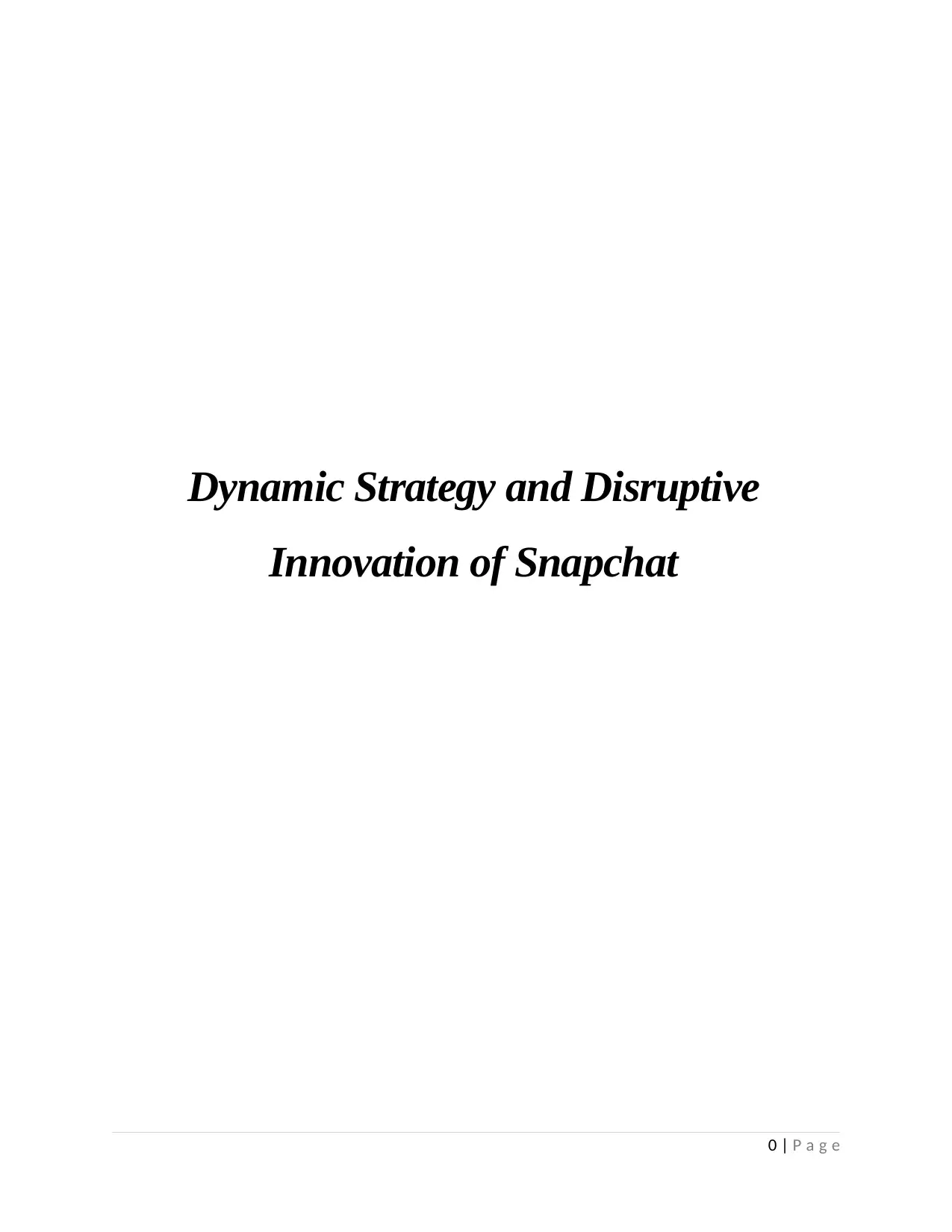
Dynamic Strategy and Disruptive
Innovation of Snapchat
0 | P a g e
Innovation of Snapchat
0 | P a g e
Paraphrase This Document
Need a fresh take? Get an instant paraphrase of this document with our AI Paraphraser
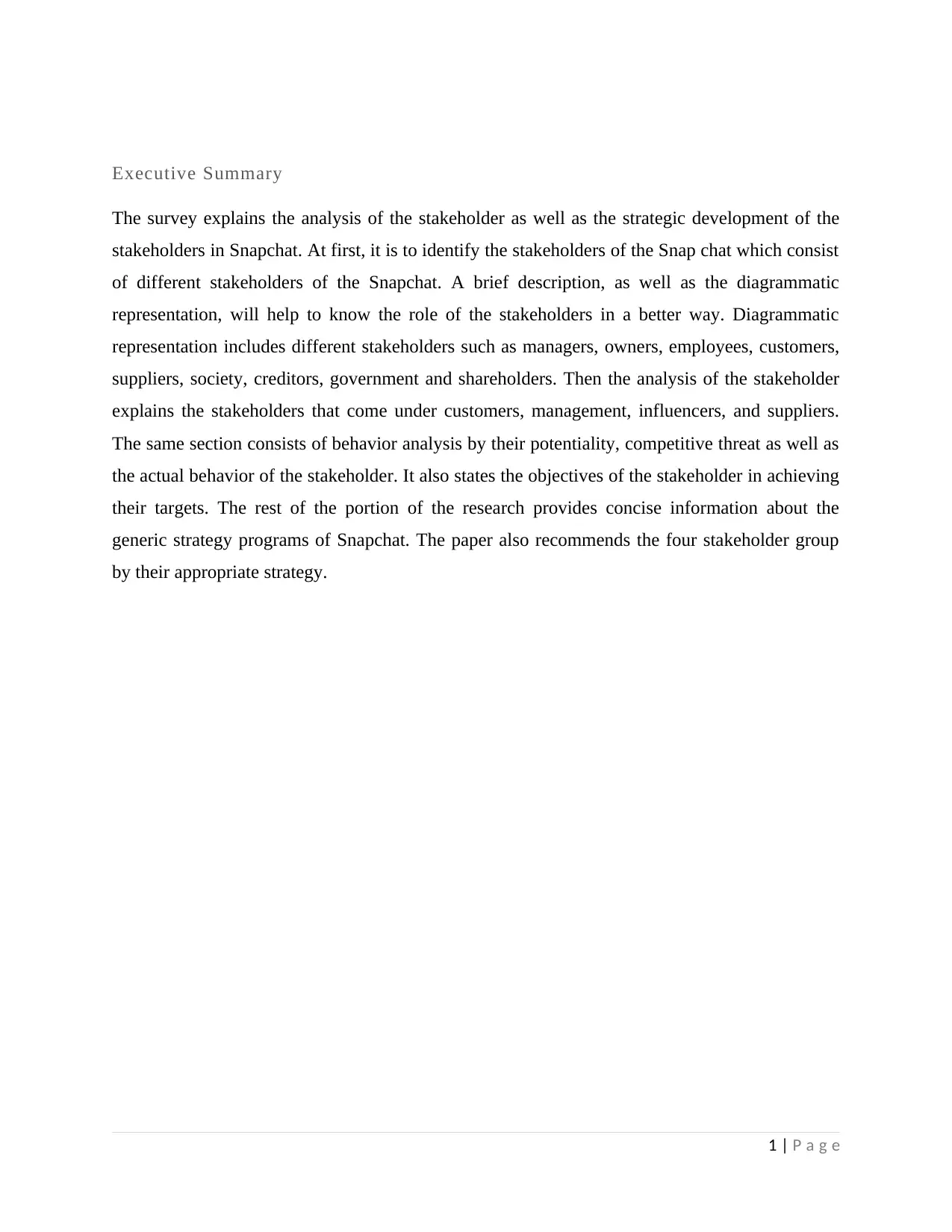
Executive Summary
The survey explains the analysis of the stakeholder as well as the strategic development of the
stakeholders in Snapchat. At first, it is to identify the stakeholders of the Snap chat which consist
of different stakeholders of the Snapchat. A brief description, as well as the diagrammatic
representation, will help to know the role of the stakeholders in a better way. Diagrammatic
representation includes different stakeholders such as managers, owners, employees, customers,
suppliers, society, creditors, government and shareholders. Then the analysis of the stakeholder
explains the stakeholders that come under customers, management, influencers, and suppliers.
The same section consists of behavior analysis by their potentiality, competitive threat as well as
the actual behavior of the stakeholder. It also states the objectives of the stakeholder in achieving
their targets. The rest of the portion of the research provides concise information about the
generic strategy programs of Snapchat. The paper also recommends the four stakeholder group
by their appropriate strategy.
1 | P a g e
The survey explains the analysis of the stakeholder as well as the strategic development of the
stakeholders in Snapchat. At first, it is to identify the stakeholders of the Snap chat which consist
of different stakeholders of the Snapchat. A brief description, as well as the diagrammatic
representation, will help to know the role of the stakeholders in a better way. Diagrammatic
representation includes different stakeholders such as managers, owners, employees, customers,
suppliers, society, creditors, government and shareholders. Then the analysis of the stakeholder
explains the stakeholders that come under customers, management, influencers, and suppliers.
The same section consists of behavior analysis by their potentiality, competitive threat as well as
the actual behavior of the stakeholder. It also states the objectives of the stakeholder in achieving
their targets. The rest of the portion of the research provides concise information about the
generic strategy programs of Snapchat. The paper also recommends the four stakeholder group
by their appropriate strategy.
1 | P a g e

Table of Contents
Introduction.................................................................................................................................................3
A. Identification of Stakeholders of Snapchat..........................................................................................3
B. Analysis of the Stakeholders................................................................................................................5
Behavior analysis....................................................................................................................................5
Motives....................................................................................................................................................6
C. Categorization of the Stakeholder and generic strategy programs...........................................................6
Classification of the Stakeholders in Snapchat........................................................................................6
Generic Strategy Programs......................................................................................................................7
D. Recommendations..................................................................................................................................8
Conclusion...................................................................................................................................................8
References...................................................................................................................................................9
2 | P a g e
Introduction.................................................................................................................................................3
A. Identification of Stakeholders of Snapchat..........................................................................................3
B. Analysis of the Stakeholders................................................................................................................5
Behavior analysis....................................................................................................................................5
Motives....................................................................................................................................................6
C. Categorization of the Stakeholder and generic strategy programs...........................................................6
Classification of the Stakeholders in Snapchat........................................................................................6
Generic Strategy Programs......................................................................................................................7
D. Recommendations..................................................................................................................................8
Conclusion...................................................................................................................................................8
References...................................................................................................................................................9
2 | P a g e
⊘ This is a preview!⊘
Do you want full access?
Subscribe today to unlock all pages.

Trusted by 1+ million students worldwide
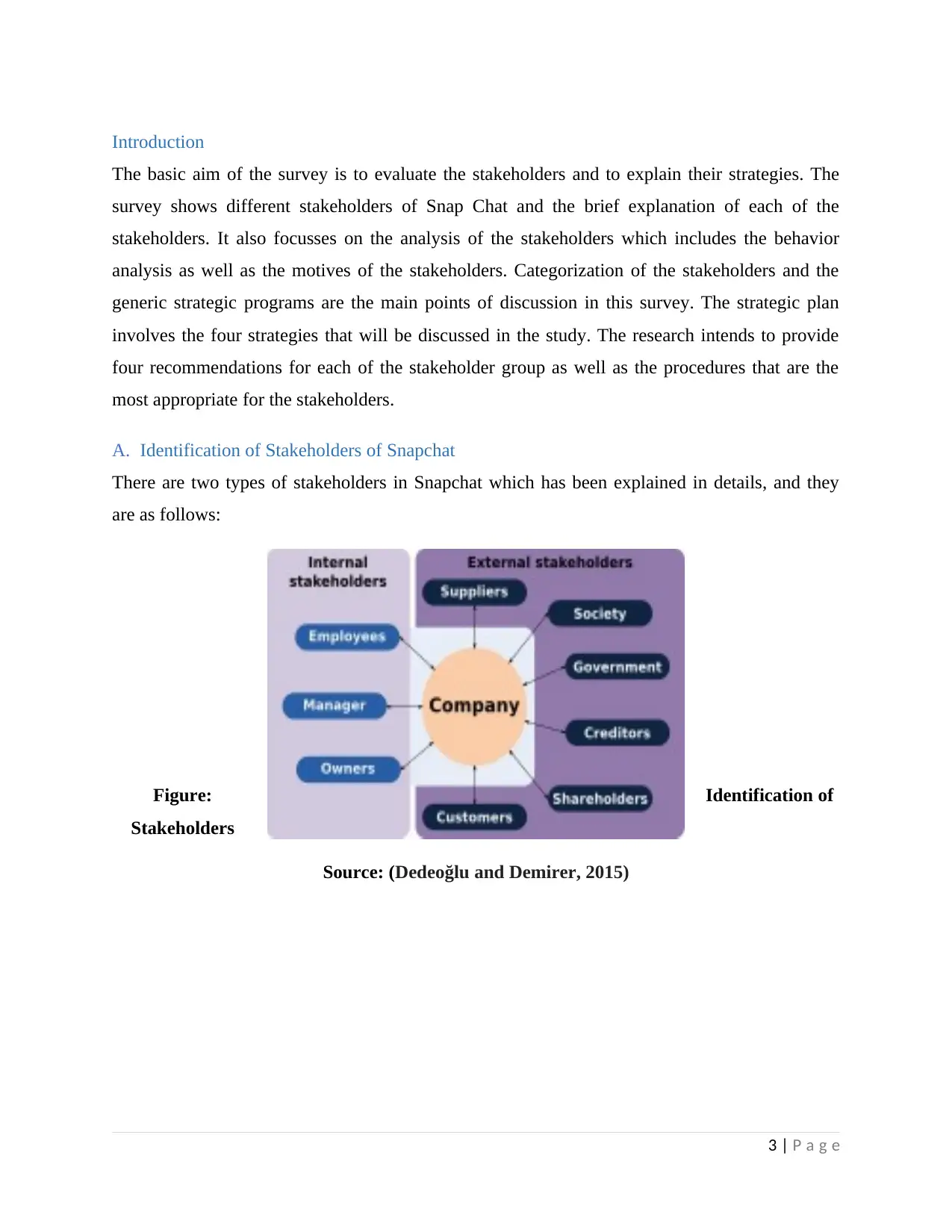
Introduction
The basic aim of the survey is to evaluate the stakeholders and to explain their strategies. The
survey shows different stakeholders of Snap Chat and the brief explanation of each of the
stakeholders. It also focusses on the analysis of the stakeholders which includes the behavior
analysis as well as the motives of the stakeholders. Categorization of the stakeholders and the
generic strategic programs are the main points of discussion in this survey. The strategic plan
involves the four strategies that will be discussed in the study. The research intends to provide
four recommendations for each of the stakeholder group as well as the procedures that are the
most appropriate for the stakeholders.
A. Identification of Stakeholders of Snapchat
There are two types of stakeholders in Snapchat which has been explained in details, and they
are as follows:
Figure: Identification of
Stakeholders
Source: (Dedeoğlu and Demirer, 2015)
3 | P a g e
The basic aim of the survey is to evaluate the stakeholders and to explain their strategies. The
survey shows different stakeholders of Snap Chat and the brief explanation of each of the
stakeholders. It also focusses on the analysis of the stakeholders which includes the behavior
analysis as well as the motives of the stakeholders. Categorization of the stakeholders and the
generic strategic programs are the main points of discussion in this survey. The strategic plan
involves the four strategies that will be discussed in the study. The research intends to provide
four recommendations for each of the stakeholder group as well as the procedures that are the
most appropriate for the stakeholders.
A. Identification of Stakeholders of Snapchat
There are two types of stakeholders in Snapchat which has been explained in details, and they
are as follows:
Figure: Identification of
Stakeholders
Source: (Dedeoğlu and Demirer, 2015)
3 | P a g e
Paraphrase This Document
Need a fresh take? Get an instant paraphrase of this document with our AI Paraphraser

Internal Stakeholders:
Managers – Managers in Snapchat are those persons who are responsible for
monitoring the ventures of the Snapchat or the staffs of the firm. They are always in
charge of carrying out some duties and regularly takes decisions about those duties.
Owners – The owners of Snapchat are liable for any risk of any ventures as it is the
duty of the owner to implement the ventures. The CEO of Snapchat Evan Spiegel has
brilliant potentials of leadership which helps him to overcome the risk factors of the
firm and also reduce the chance of risks in the future (Dedeoğlu and Demirer, 2015).
Employees – In a corporate firm like Snapchat, an employee is a person who has
been engaged to give facilities to the firm regularly in return of salary either based on
their hours of working or on a yearly basis (Fei, 2016). If in any case, Snapchat loses
any staff it might affect their customer service. So Snapchat has to give a proposal
for an attractive term and conditions for their teams to retain their good workers.
External Stakeholders:
Society – Any successful firms are building the basis of the culture, and the firm
creates their policies for the improvement of the culture and its peoples. Therefore, it
could be noticed that Snapchat has contributed to the society in the form of their
thriving business.
Customers – Snapchat gives immense importance to their users as without them the
business of Snapchat could not grow (Barnett, 2018). The customers of Snapchat
helps to run their business effectively, and the firm too enticed them with their
different offers. About 60% of the people in the UK are utilizing the facilities of
Snapchat.
Suppliers – To run their organization effectively, it is vital for Snapchat to
collaborate with the suppliers (Ferretti, 2016). Most of the suppliers are expert in
their works, so the firm needs to collaborate with them on the long-term basis.
Government – Snapchat seriously follows the laws of the government to run their
firm effectively. But sometimes Snapchat needs to go against the law if the firm
thinks it to be wrong and also avoid the trials and arguments.
4 | P a g e
Managers – Managers in Snapchat are those persons who are responsible for
monitoring the ventures of the Snapchat or the staffs of the firm. They are always in
charge of carrying out some duties and regularly takes decisions about those duties.
Owners – The owners of Snapchat are liable for any risk of any ventures as it is the
duty of the owner to implement the ventures. The CEO of Snapchat Evan Spiegel has
brilliant potentials of leadership which helps him to overcome the risk factors of the
firm and also reduce the chance of risks in the future (Dedeoğlu and Demirer, 2015).
Employees – In a corporate firm like Snapchat, an employee is a person who has
been engaged to give facilities to the firm regularly in return of salary either based on
their hours of working or on a yearly basis (Fei, 2016). If in any case, Snapchat loses
any staff it might affect their customer service. So Snapchat has to give a proposal
for an attractive term and conditions for their teams to retain their good workers.
External Stakeholders:
Society – Any successful firms are building the basis of the culture, and the firm
creates their policies for the improvement of the culture and its peoples. Therefore, it
could be noticed that Snapchat has contributed to the society in the form of their
thriving business.
Customers – Snapchat gives immense importance to their users as without them the
business of Snapchat could not grow (Barnett, 2018). The customers of Snapchat
helps to run their business effectively, and the firm too enticed them with their
different offers. About 60% of the people in the UK are utilizing the facilities of
Snapchat.
Suppliers – To run their organization effectively, it is vital for Snapchat to
collaborate with the suppliers (Ferretti, 2016). Most of the suppliers are expert in
their works, so the firm needs to collaborate with them on the long-term basis.
Government – Snapchat seriously follows the laws of the government to run their
firm effectively. But sometimes Snapchat needs to go against the law if the firm
thinks it to be wrong and also avoid the trials and arguments.
4 | P a g e
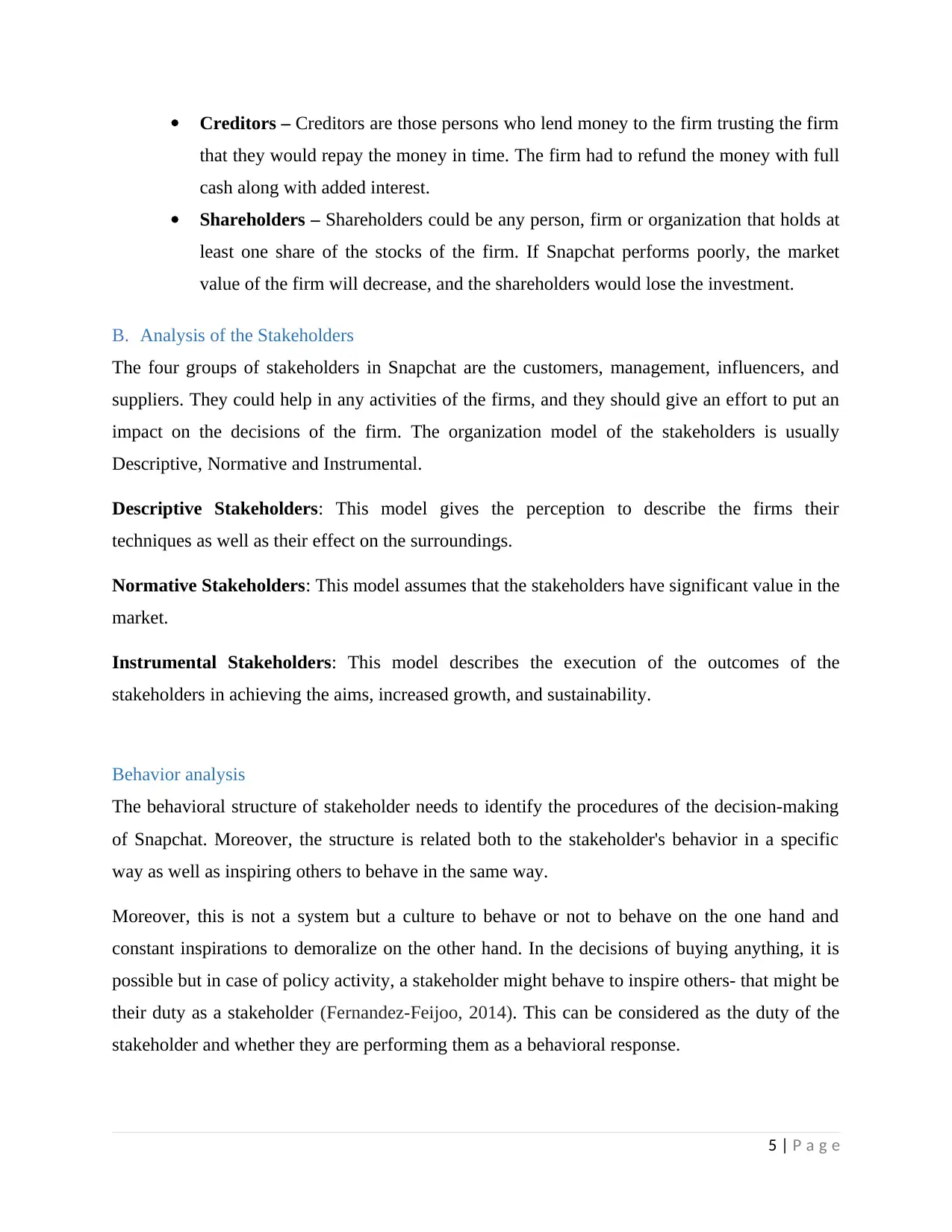
Creditors – Creditors are those persons who lend money to the firm trusting the firm
that they would repay the money in time. The firm had to refund the money with full
cash along with added interest.
Shareholders – Shareholders could be any person, firm or organization that holds at
least one share of the stocks of the firm. If Snapchat performs poorly, the market
value of the firm will decrease, and the shareholders would lose the investment.
B. Analysis of the Stakeholders
The four groups of stakeholders in Snapchat are the customers, management, influencers, and
suppliers. They could help in any activities of the firms, and they should give an effort to put an
impact on the decisions of the firm. The organization model of the stakeholders is usually
Descriptive, Normative and Instrumental.
Descriptive Stakeholders: This model gives the perception to describe the firms their
techniques as well as their effect on the surroundings.
Normative Stakeholders: This model assumes that the stakeholders have significant value in the
market.
Instrumental Stakeholders: This model describes the execution of the outcomes of the
stakeholders in achieving the aims, increased growth, and sustainability.
Behavior analysis
The behavioral structure of stakeholder needs to identify the procedures of the decision-making
of Snapchat. Moreover, the structure is related both to the stakeholder's behavior in a specific
way as well as inspiring others to behave in the same way.
Moreover, this is not a system but a culture to behave or not to behave on the one hand and
constant inspirations to demoralize on the other hand. In the decisions of buying anything, it is
possible but in case of policy activity, a stakeholder might behave to inspire others- that might be
their duty as a stakeholder (Fernandez-Feijoo, 2014). This can be considered as the duty of the
stakeholder and whether they are performing them as a behavioral response.
5 | P a g e
that they would repay the money in time. The firm had to refund the money with full
cash along with added interest.
Shareholders – Shareholders could be any person, firm or organization that holds at
least one share of the stocks of the firm. If Snapchat performs poorly, the market
value of the firm will decrease, and the shareholders would lose the investment.
B. Analysis of the Stakeholders
The four groups of stakeholders in Snapchat are the customers, management, influencers, and
suppliers. They could help in any activities of the firms, and they should give an effort to put an
impact on the decisions of the firm. The organization model of the stakeholders is usually
Descriptive, Normative and Instrumental.
Descriptive Stakeholders: This model gives the perception to describe the firms their
techniques as well as their effect on the surroundings.
Normative Stakeholders: This model assumes that the stakeholders have significant value in the
market.
Instrumental Stakeholders: This model describes the execution of the outcomes of the
stakeholders in achieving the aims, increased growth, and sustainability.
Behavior analysis
The behavioral structure of stakeholder needs to identify the procedures of the decision-making
of Snapchat. Moreover, the structure is related both to the stakeholder's behavior in a specific
way as well as inspiring others to behave in the same way.
Moreover, this is not a system but a culture to behave or not to behave on the one hand and
constant inspirations to demoralize on the other hand. In the decisions of buying anything, it is
possible but in case of policy activity, a stakeholder might behave to inspire others- that might be
their duty as a stakeholder (Fernandez-Feijoo, 2014). This can be considered as the duty of the
stakeholder and whether they are performing them as a behavioral response.
5 | P a g e
⊘ This is a preview!⊘
Do you want full access?
Subscribe today to unlock all pages.

Trusted by 1+ million students worldwide

Motives
The stakeholders of Snapchat had various aims and goals by their interest in the firm. These aims
are connected to their purpose of achieving their targets. Each and every stakeholders has their
own personal motives in Snapchat.
1. Customers – Customers are those persons who would utilize the facilities of the venture
or programs of Snapchat. These could be users or other internal departments of the firm.
In the case of distributing new software for the sales team of Snapchat, the customers
would be the sales members of Snapchat (Jones, 2016).
2. Management – These could be the person or a group of persons those who have
curiosity in the management of the ventures or other programs of Snapchat. Board
members of Snapchat and accountants, managers of the firms, are included in this group
(Vracheva, Judge and Madden, 2016).
3. Suppliers – Various types of dealers and retailers of the firm are in this group, but
company's partner, short-term workers and any person else who could give facilities to
the ventures or programs of Snapchat could come under this group.
4. Influencers – These are the persons who can change the direction of the ventures or
programs of Snapchat (Korschun, 2015). Local newspaper and trade unions could be a
good source of influencing the people about any new services of the firm.
C. Categorization of the Stakeholder and generic strategy programs
Classification of the Stakeholders in Snapchat
The four categories of stakeholders in Snapchat are primary stakeholders, secondary
stakeholders, excluded stakeholders and connected stakeholders. The details of this categories
are as follows:
1. Primary Stakeholders – These stakeholders are involved in the financial transactions of
the business of Snapchat. Customers, suppliers, shareholders, creditors and employees are
included in this group.
2. Secondary Stakeholders – These stakeholders are not directly involved in the financial
transactions of the business of Snapchat but are affected by the activities of the firm.
6 | P a g e
The stakeholders of Snapchat had various aims and goals by their interest in the firm. These aims
are connected to their purpose of achieving their targets. Each and every stakeholders has their
own personal motives in Snapchat.
1. Customers – Customers are those persons who would utilize the facilities of the venture
or programs of Snapchat. These could be users or other internal departments of the firm.
In the case of distributing new software for the sales team of Snapchat, the customers
would be the sales members of Snapchat (Jones, 2016).
2. Management – These could be the person or a group of persons those who have
curiosity in the management of the ventures or other programs of Snapchat. Board
members of Snapchat and accountants, managers of the firms, are included in this group
(Vracheva, Judge and Madden, 2016).
3. Suppliers – Various types of dealers and retailers of the firm are in this group, but
company's partner, short-term workers and any person else who could give facilities to
the ventures or programs of Snapchat could come under this group.
4. Influencers – These are the persons who can change the direction of the ventures or
programs of Snapchat (Korschun, 2015). Local newspaper and trade unions could be a
good source of influencing the people about any new services of the firm.
C. Categorization of the Stakeholder and generic strategy programs
Classification of the Stakeholders in Snapchat
The four categories of stakeholders in Snapchat are primary stakeholders, secondary
stakeholders, excluded stakeholders and connected stakeholders. The details of this categories
are as follows:
1. Primary Stakeholders – These stakeholders are involved in the financial transactions of
the business of Snapchat. Customers, suppliers, shareholders, creditors and employees are
included in this group.
2. Secondary Stakeholders – These stakeholders are not directly involved in the financial
transactions of the business of Snapchat but are affected by the activities of the firm.
6 | P a g e
Paraphrase This Document
Need a fresh take? Get an instant paraphrase of this document with our AI Paraphraser
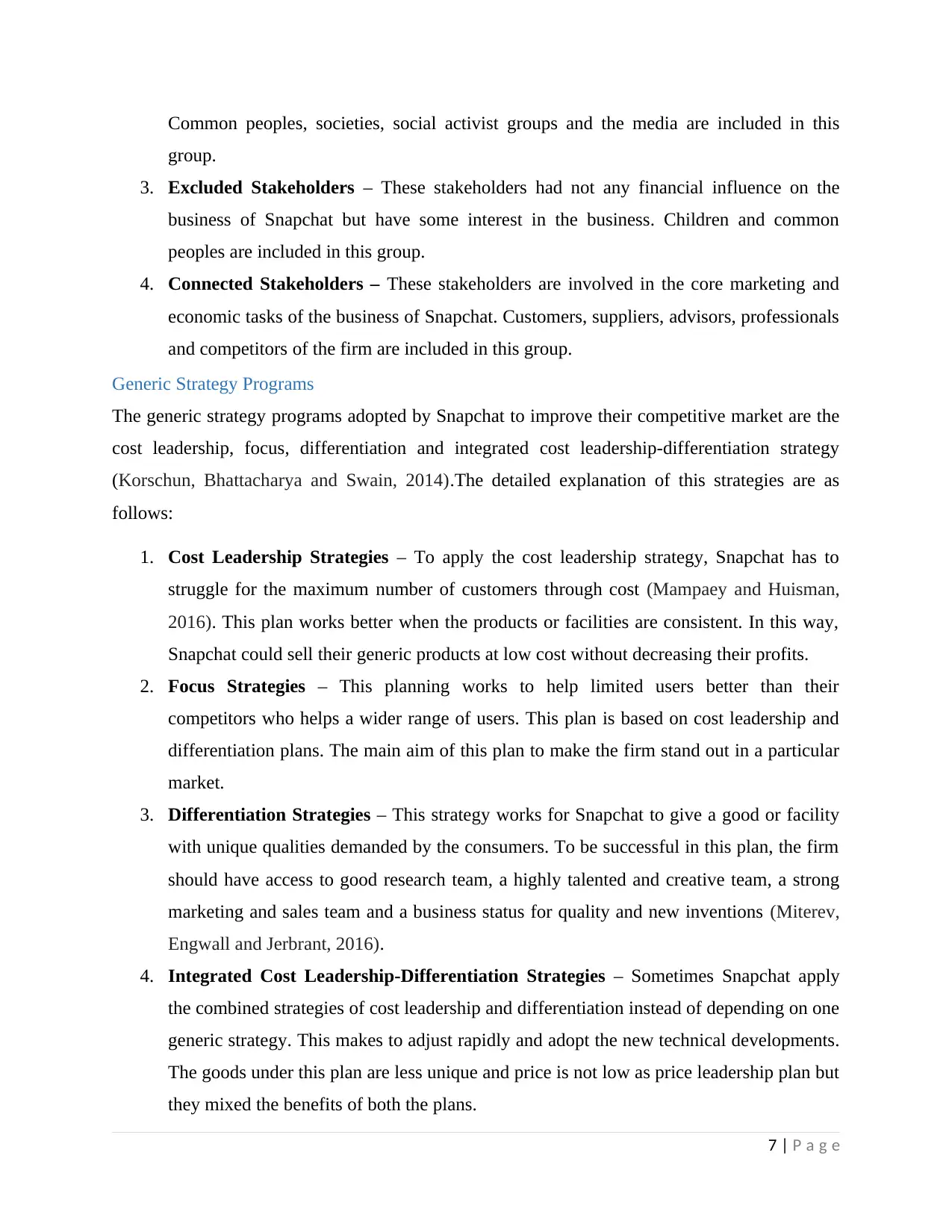
Common peoples, societies, social activist groups and the media are included in this
group.
3. Excluded Stakeholders – These stakeholders had not any financial influence on the
business of Snapchat but have some interest in the business. Children and common
peoples are included in this group.
4. Connected Stakeholders – These stakeholders are involved in the core marketing and
economic tasks of the business of Snapchat. Customers, suppliers, advisors, professionals
and competitors of the firm are included in this group.
Generic Strategy Programs
The generic strategy programs adopted by Snapchat to improve their competitive market are the
cost leadership, focus, differentiation and integrated cost leadership-differentiation strategy
(Korschun, Bhattacharya and Swain, 2014).The detailed explanation of this strategies are as
follows:
1. Cost Leadership Strategies – To apply the cost leadership strategy, Snapchat has to
struggle for the maximum number of customers through cost (Mampaey and Huisman,
2016). This plan works better when the products or facilities are consistent. In this way,
Snapchat could sell their generic products at low cost without decreasing their profits.
2. Focus Strategies – This planning works to help limited users better than their
competitors who helps a wider range of users. This plan is based on cost leadership and
differentiation plans. The main aim of this plan to make the firm stand out in a particular
market.
3. Differentiation Strategies – This strategy works for Snapchat to give a good or facility
with unique qualities demanded by the consumers. To be successful in this plan, the firm
should have access to good research team, a highly talented and creative team, a strong
marketing and sales team and a business status for quality and new inventions (Miterev,
Engwall and Jerbrant, 2016).
4. Integrated Cost Leadership-Differentiation Strategies – Sometimes Snapchat apply
the combined strategies of cost leadership and differentiation instead of depending on one
generic strategy. This makes to adjust rapidly and adopt the new technical developments.
The goods under this plan are less unique and price is not low as price leadership plan but
they mixed the benefits of both the plans.
7 | P a g e
group.
3. Excluded Stakeholders – These stakeholders had not any financial influence on the
business of Snapchat but have some interest in the business. Children and common
peoples are included in this group.
4. Connected Stakeholders – These stakeholders are involved in the core marketing and
economic tasks of the business of Snapchat. Customers, suppliers, advisors, professionals
and competitors of the firm are included in this group.
Generic Strategy Programs
The generic strategy programs adopted by Snapchat to improve their competitive market are the
cost leadership, focus, differentiation and integrated cost leadership-differentiation strategy
(Korschun, Bhattacharya and Swain, 2014).The detailed explanation of this strategies are as
follows:
1. Cost Leadership Strategies – To apply the cost leadership strategy, Snapchat has to
struggle for the maximum number of customers through cost (Mampaey and Huisman,
2016). This plan works better when the products or facilities are consistent. In this way,
Snapchat could sell their generic products at low cost without decreasing their profits.
2. Focus Strategies – This planning works to help limited users better than their
competitors who helps a wider range of users. This plan is based on cost leadership and
differentiation plans. The main aim of this plan to make the firm stand out in a particular
market.
3. Differentiation Strategies – This strategy works for Snapchat to give a good or facility
with unique qualities demanded by the consumers. To be successful in this plan, the firm
should have access to good research team, a highly talented and creative team, a strong
marketing and sales team and a business status for quality and new inventions (Miterev,
Engwall and Jerbrant, 2016).
4. Integrated Cost Leadership-Differentiation Strategies – Sometimes Snapchat apply
the combined strategies of cost leadership and differentiation instead of depending on one
generic strategy. This makes to adjust rapidly and adopt the new technical developments.
The goods under this plan are less unique and price is not low as price leadership plan but
they mixed the benefits of both the plans.
7 | P a g e

D. Recommendations
While addressing the stakeholder group, it is strongly recommended to the owners to create a
long-term plan as well as the strategy for retaining the trust of the users. Snapchat should utilize
the social networking site to interact with the customers and also conduct surveys to know the
feedback from the customers (Ranängen, 2015). Moreover, one of the recommendations is
respect and understand the customers as well listen to them. The employees are recommended to
be honest, supportive as well as a respectful. As the employees are the most significant
stakeholder so it is strongly recommended that the employee, as well as other business
associates, should work in a team. The employees are advised to manage the business by
applying new strategies.
The suppliers are recommended to gain the trust of the customer’s by providing superior quality
of goods and facilities to the consumers (Sanderson, 2017). The assets that are produced must be
of suitable price as well must be delivered at the right time. The customers are especially
recommended to inspect the product before purchasing. It is also recommended to the customers
that to give the correct value to the products. It is the prime duty of the customer to choose the
appropriate supplier who provides high-quality products.
After evaluating the strategic plans, it is recommended that differentiation strategy is the best
generic strategy (Scandelius and Cohen, 2016). Under the differentiation strategy, customers of
Snapchat receives unique goods and facilities that are demanded by them. The basic resources
and the goods are not so important because the products are the users itself. Only with range
through a large base of customers, the business of Snapchat is running effectively. Customers are
those persons who utilizes the facilities of the venture or programs of Snapchat.
Conclusion
It can be concluded that different stakeholders are responsible for managing the strategic
development of the business. The analysis of the stakeholders presented the importance of
behavior analysis for the stakeholders. It can be seen that the motives of the stakeholder are to
achieve the targets. The survey also focused on the generic strategic programs for the
8 | P a g e
While addressing the stakeholder group, it is strongly recommended to the owners to create a
long-term plan as well as the strategy for retaining the trust of the users. Snapchat should utilize
the social networking site to interact with the customers and also conduct surveys to know the
feedback from the customers (Ranängen, 2015). Moreover, one of the recommendations is
respect and understand the customers as well listen to them. The employees are recommended to
be honest, supportive as well as a respectful. As the employees are the most significant
stakeholder so it is strongly recommended that the employee, as well as other business
associates, should work in a team. The employees are advised to manage the business by
applying new strategies.
The suppliers are recommended to gain the trust of the customer’s by providing superior quality
of goods and facilities to the consumers (Sanderson, 2017). The assets that are produced must be
of suitable price as well must be delivered at the right time. The customers are especially
recommended to inspect the product before purchasing. It is also recommended to the customers
that to give the correct value to the products. It is the prime duty of the customer to choose the
appropriate supplier who provides high-quality products.
After evaluating the strategic plans, it is recommended that differentiation strategy is the best
generic strategy (Scandelius and Cohen, 2016). Under the differentiation strategy, customers of
Snapchat receives unique goods and facilities that are demanded by them. The basic resources
and the goods are not so important because the products are the users itself. Only with range
through a large base of customers, the business of Snapchat is running effectively. Customers are
those persons who utilizes the facilities of the venture or programs of Snapchat.
Conclusion
It can be concluded that different stakeholders are responsible for managing the strategic
development of the business. The analysis of the stakeholders presented the importance of
behavior analysis for the stakeholders. It can be seen that the motives of the stakeholder are to
achieve the targets. The survey also focused on the generic strategic programs for the
8 | P a g e
⊘ This is a preview!⊘
Do you want full access?
Subscribe today to unlock all pages.

Trusted by 1+ million students worldwide

development of the strategy of Snapchat. The review gave detailed information about the four
policies that apply to Snapchat. Therefore, the survey presented the overall view of stakeholder
analysis as well as strategic development concisely.
References
Barnett, M.L., 2018. Influence Stakeholders, Influence the World. In Social Movements,
Stakeholders and Non-Market Strategy (pp. 247-258). Emerald Publishing Limited.
Dedeoğlu, B.B. and Demirer, H., 2015. Differences in service quality perceptions of stakeholders
in the hotel industry. International Journal of Contemporary Hospitality Management, 27(1),
pp.130-146.
Fei, W., 2016. Stakeholders’ Behavior Analysis and Enterprise Management Strategy Selection
in Chinese Ancient Village Tourism Development. In Game Theory and Applications (pp. 53-
71). Springer, Singapore.
Fernandez-Feijoo, B., Romero, S. and Ruiz, S., 2014. Effect of stakeholders' pressure on the
transparency of sustainability reports within the GRI framework. Journal of business
ethics, 122(1), pp.53-63.
Ferretti, V., 2016. From stakeholders analysis of cognitive mapping and Multi-Attribute Value
Theory: An integrated approach for policy support. European Journal of Operational
Research, 253(2), pp.524-541.
Jones, D., Florentino, H., Cane, D. and Oliveira, R., 2016. An extended goal programming
methodology for analysis of a network encompassing multiple objectives and stakeholders.
European Journal of Operational Research, 255(3), pp.845-855.
Korschun, D., 2015. Boundary-spanning employees and relationships with external stakeholders:
A social identity approach. Academy of Management Review, 40(4), pp.611-629.
Korschun, D., Bhattacharya, C.B. and Swain, S.D., 2014. Corporate social responsibility,
customer orientation, and the job performance of frontline employees. Journal of
Marketing, 78(3), pp.20-37.
9 | P a g e
policies that apply to Snapchat. Therefore, the survey presented the overall view of stakeholder
analysis as well as strategic development concisely.
References
Barnett, M.L., 2018. Influence Stakeholders, Influence the World. In Social Movements,
Stakeholders and Non-Market Strategy (pp. 247-258). Emerald Publishing Limited.
Dedeoğlu, B.B. and Demirer, H., 2015. Differences in service quality perceptions of stakeholders
in the hotel industry. International Journal of Contemporary Hospitality Management, 27(1),
pp.130-146.
Fei, W., 2016. Stakeholders’ Behavior Analysis and Enterprise Management Strategy Selection
in Chinese Ancient Village Tourism Development. In Game Theory and Applications (pp. 53-
71). Springer, Singapore.
Fernandez-Feijoo, B., Romero, S. and Ruiz, S., 2014. Effect of stakeholders' pressure on the
transparency of sustainability reports within the GRI framework. Journal of business
ethics, 122(1), pp.53-63.
Ferretti, V., 2016. From stakeholders analysis of cognitive mapping and Multi-Attribute Value
Theory: An integrated approach for policy support. European Journal of Operational
Research, 253(2), pp.524-541.
Jones, D., Florentino, H., Cane, D. and Oliveira, R., 2016. An extended goal programming
methodology for analysis of a network encompassing multiple objectives and stakeholders.
European Journal of Operational Research, 255(3), pp.845-855.
Korschun, D., 2015. Boundary-spanning employees and relationships with external stakeholders:
A social identity approach. Academy of Management Review, 40(4), pp.611-629.
Korschun, D., Bhattacharya, C.B. and Swain, S.D., 2014. Corporate social responsibility,
customer orientation, and the job performance of frontline employees. Journal of
Marketing, 78(3), pp.20-37.
9 | P a g e
Paraphrase This Document
Need a fresh take? Get an instant paraphrase of this document with our AI Paraphraser

Mampaey, J. and Huisman, J., 2016. Defensive stakeholder management in European
universities: an institutional logics perspective. Studies in Higher Education, 41(12), pp.2218-
2231.
Miterev, M., Engwall, M. and Jerbrant, A., 2016. Exploring program management competencies
for various program types. International Journal of Project Management, 34(3), pp.545-557.
Ranängen, H., 2015. Stakeholder management in reality: Moving from conceptual frameworks to
operational strategies and interactions. Sustainable Production and Consumption, 3, pp.21-33.
Sanderson, J., 2017. Guarding against quick and easy: tightening up the qualitative sport and
social media research. In Digital Qualitative Research in Sport and Physical Activity (pp. 92-
104). Routledge.
Scandelius, C. and Cohen, G., 2016. Achieving collaboration with diverse stakeholders—The
role of strategic ambiguity in CSR communication. Journal of Business Research, 69(9),
pp.3487-3499.
Vracheva, V., Judge, W.Q. and Madden, T., 2016. Enterprise strategy concept, measurement,
and validation: Integrating stakeholder engagement into the firm's strategic
architecture. European Management Journal, 34(4), pp.374-385.
Watkins, B. and Lee, J.W., 2016. Communicating brand identity on social media: A case study
of the use of Instagram and Twitter for collegiate athletic branding. International Journal of
Sport Communication, 9(4), pp.476-498.
Yang, R.J., Wang, Y. and Jin, X.H., 2014. Stakeholders’ attributes, behaviors, and decision‐
making strategies in construction projects: importance and correlations in practice. Project
Management Journal, 45(3), pp.74-90.
10 | P a g e
universities: an institutional logics perspective. Studies in Higher Education, 41(12), pp.2218-
2231.
Miterev, M., Engwall, M. and Jerbrant, A., 2016. Exploring program management competencies
for various program types. International Journal of Project Management, 34(3), pp.545-557.
Ranängen, H., 2015. Stakeholder management in reality: Moving from conceptual frameworks to
operational strategies and interactions. Sustainable Production and Consumption, 3, pp.21-33.
Sanderson, J., 2017. Guarding against quick and easy: tightening up the qualitative sport and
social media research. In Digital Qualitative Research in Sport and Physical Activity (pp. 92-
104). Routledge.
Scandelius, C. and Cohen, G., 2016. Achieving collaboration with diverse stakeholders—The
role of strategic ambiguity in CSR communication. Journal of Business Research, 69(9),
pp.3487-3499.
Vracheva, V., Judge, W.Q. and Madden, T., 2016. Enterprise strategy concept, measurement,
and validation: Integrating stakeholder engagement into the firm's strategic
architecture. European Management Journal, 34(4), pp.374-385.
Watkins, B. and Lee, J.W., 2016. Communicating brand identity on social media: A case study
of the use of Instagram and Twitter for collegiate athletic branding. International Journal of
Sport Communication, 9(4), pp.476-498.
Yang, R.J., Wang, Y. and Jin, X.H., 2014. Stakeholders’ attributes, behaviors, and decision‐
making strategies in construction projects: importance and correlations in practice. Project
Management Journal, 45(3), pp.74-90.
10 | P a g e

11 | P a g e
⊘ This is a preview!⊘
Do you want full access?
Subscribe today to unlock all pages.

Trusted by 1+ million students worldwide
1 out of 12
Related Documents
Your All-in-One AI-Powered Toolkit for Academic Success.
+13062052269
info@desklib.com
Available 24*7 on WhatsApp / Email
![[object Object]](/_next/static/media/star-bottom.7253800d.svg)
Unlock your academic potential
Copyright © 2020–2025 A2Z Services. All Rights Reserved. Developed and managed by ZUCOL.





